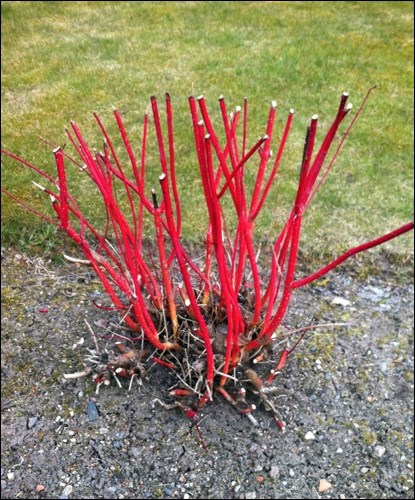Most people seldom think of the winter landscape beyond the snow, hoar frost, icicles and cold. But there’s much in the plant world to appreciate at this time of year. It was a friend of mine, Mae, who reminded me of this. “We often buy plants for their summer leaf or flower appearances but that can only be appreciated seven months of the year at most.” She included a newspaper clipping from her local newspaper about how tree and shrub barks add an often forgotten dimension to your garden.
And how true this is. From my time on the West Coast, I remember the evergreen arbutus trees (Arbutus menziesii) with their year-round coppery peeling bark. On the prairies, we have some showstoppers of our own. Take the Amur chokecherry (Prunus maackii). In early spring it is covered in fragrant creamy white blossoms, it attracts birds in the fall with its small black cherries, but throughout the year it has bright coppery bark. Then there’s the white birch (Betula papyrifera) with its white bark. And while most other trees have brown or grey bark, they all have interesting features like furrows that form a diamond-patterned lattice over the trunk, smooth silvery or grey bark, knots, deep grooves and other features. A seldom planted, hard to find but hardy tree, the Amur cork tree (Phellodendron amurense) has soft, corky, wavy ridged bark. Take a look on the north side of a mature tree and you may discover a colourful network of lichens and moss.
Interesting bark is not just limited to deciduous trees. As I child I would make my way under the canopy of pines (Pinus spp.) and peel of the surface bark chips to reveal the nutmeg brown of unweathered bark. Jack and Scots pine (P. banksiana and P. sylvestris) are naturally tan-coloured and more easily shed their bark chips. Fir trees (Abies spp.) have smooth silver grey bark that shines through the foliage.
There are also many shrubs that lend their bark to the landscape appeal. Red osier dogwood (Cornus sericea; also Siberian dogwood, C. alba) has been selected for many features like leaf colour (yellow, variegated, purple hue) and plant size. But it is its bark colour that gives red osier dogwood its name. One cultivar, Coral (C. alba Coral), has especially arresting, bright coral-pink stems. Similarly, yellow twig dogwood (C. sericea Flaviramea and C. sericea Lutea) has gleaming canary-yellow stems. Tip: it is only the young growth that displays so brightly in late winter and early spring. So in the early spring, before leaf out, either remove the oldest, dullest branches, no more than a third each year or every three years cut the entire shrub down to four inches.
Other shrubs have winged branches (winged burning bush, Euonymus alatus), shaggy bark (honeysuckle, Lonicera ssp.; ninebark, Physocarpus opulifolius) and twisted branches (Harry Lauder’s walking stick, Corylus avellana ‘Contorta’ – borderline hardy).
Mae went on to say her letter that the news clipping “reminded me about the ‘winter flowers’ I used to pick at home when I was little.” As she learned more about plants she discovered they were only the dead remnants of fall blooming wildflowers – goldenrod, yarrow, cow parsnip and smooth aster. “Still the memory is just as beautiful.”
These dead remnants are more alive than one might expect. They contain the seeds for coming season, attract birds and other animals and add interest to winter garden. Take a look at your own garden and you’ll discover your own ‘winter flowers’ such as swollen black rose hips, seed heads waving over the snow from your ornamental grasses and dried hydrangea flower clusters and much more.
— This column is provided courtesy of the Saskatchewan Perennial Society (www.saskperennial.ca; hortscene@yahoo.com). Check out our Bulletin Board or Calendar for upcoming garden information sessions: Feb.25: SK Perennial Society AGM followed by a video presentation - A Family Garden: The Butchart Gardens.



